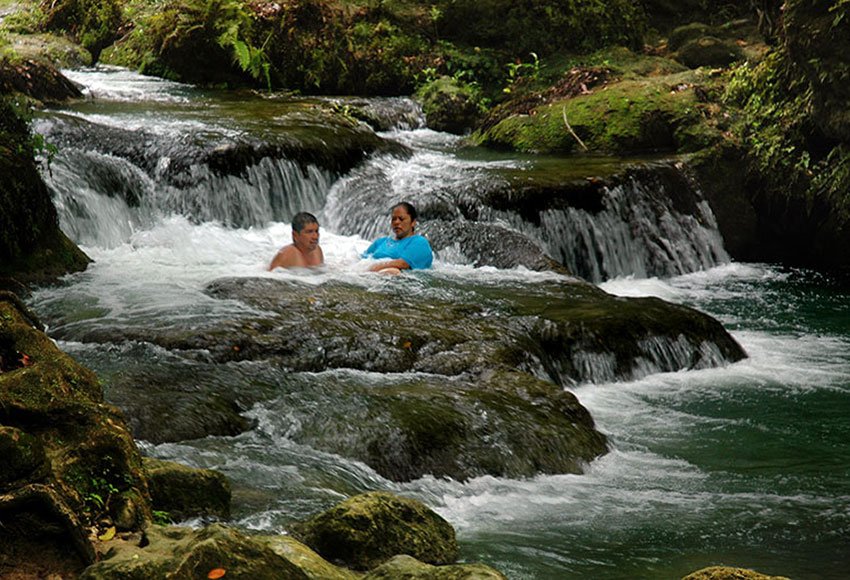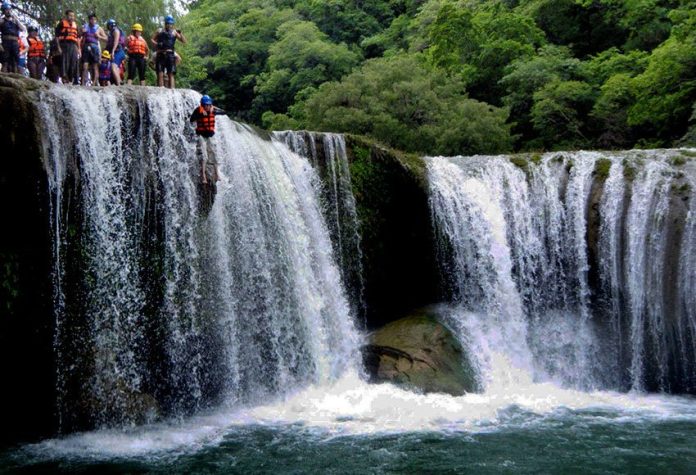Guadalajara has several very well organized clubs specializing in outdoor activities like hiking, camping and mountain-climbing. They offer excursions every weekend of the year and their members get to see natural marvels that most tourist guidebooks never mention (except my book, Outdoors in Western Mexico, of course!)
Some of these groups have been around for a long time, so today’s members benefit from discoveries of little-known sites made by other members decades ago.
Grupo Montañista Colli is a non-profit club dedicated to promoting love and respect for nature under the guidance of dedicated and experienced personnel since 1962.
One of many nice things about its leaders and members is that they welcome newcomers, even old gringos like me so, thanks to Grupo Colli, I was able to visit the gloriously beautiful rivers and waterfalls of La Huasteca Potosina, about which I had previously known nothing.
If you find all of this interesting, you might want to look up “grupos de montañismo/senderismo/excursionismo” in your area.

La Huasteca is one of Mexico’s most beautiful regions, and includes parts of seven states. It is so called because it was formerly the stomping grounds of the Huastec Indians — before they were sold into slavery by the infamous Spaniard Nuño de Guzmán. La Huasteca is one of Mexico’s most bio-diverse regions, dominated by tropical rainforest and housing more than 2,000 species of plants.
The small area I would be visiting, La Huasteca Potosina, lies within the state of San Luis Potosí and is filled with picture-postcard waterfalls in rivers that flow eastward from the mountains of the Sierra Madre Oriental. I was told I should not miss the glorious waterfalls of Micos and the stupendous Cascada de Tamul, 105 meters high.
The area is also famous for its sinkholes and caves, including El Sótano de las Golondrinas, a pit down which enthusiasts rappel 333 meters, in a single jump, to reach the bottom.
To travel to San Luis Potosí, Grupo Colli arranged for us to board their bus at night. During the eight-hour trip I slept like a baby thanks to a sleeping pill and woke up refreshed the next morning in front of the Hotel-Spa Taninul, located 10 kilometers southeast of Ciudad Valles.
A few hours later, we were driving toward the famed waterfalls of Micos — driving, I say, not speeding, as these buses are, fortunately, unable to exceed 95 kilometers per hour.
Micos means spider monkeys, which were once abundant in the region but these days it really means breathtakingly beautiful cascades and pools of turquoise-blue water, as clear as crystal and “room temperature:” just perfect for swimming.

On arrival, we split into two groups: those who would don life jackets and leap or slide down seven falls over a one-kilometer stretch of Río el Salto, and those who preferred a leisurely swim in the “flatter” part of the river downstream — replete with exquisite mini-falls.
What was it like for the cascading group? My friend Luis recalls: “I stood atop the tallest fall, nine meters high and looked down at the tiny pool far below me. One of my two ever-conflicting personalities said, ‘Híjole, this is lunacy!’ and tried to pull back. But my dark side shouted, ‘Go for it!’ and pushed me right over the edge with no further ado. What an adrenalin rush!”
Group No. 2’s heartbeats were also accelerated a bit because they had to descend some 600 stairs to reach the river, after which it was pure relaxation, lolling in any one of hundreds of frothing natural Jacuzzis while balancing a frosty can of Modelo on your belly — ah, what a life!
Later, back at the Taninul Hotel, we could hike, explore a cave, fly through the air on zip lines or steam ourselves in a temazcal and finally soak in a pool of sulfur-rich hot-spring water. Enough said?
The next day, we were on the bus at 6:00am and drove to the Tampaon River where we climbed into long wooden boats called pangas, which we then rowed upstream until we came to rapids, at which point we hiked along the shore while our guides pulled the boats past the flying foam.
This picturesque river, whose waters once again are room temperature, is bordered on both sides by high cliffs and spectacular, white, limestone spires, among which, I was told, one can sometimes spot spider monkeys, onzas (perhaps cougars), badgers and even jaguars!
[soliloquy id="79519"]
Paddling again, we slowly approached majestic Tamul Falls, 105 meters (344 feet) high and of such beauty that we all concurred it was well worth all the rowing and sweating. On the way back, we stopped at a flooded cave to swim or float in its (to our surprise) ice-cold water.
The day was topped off by a meal featuring one of the most delicious dishes I’ve ever eaten anywhere in the world. It’s a specialty of San Luis Potosí called zacahuil. The ingredients are chicken, cracked-corn meal and yummy spices, all wrapped in banana leaves and baked for eight to 10 hours. Amazingly, even the chicken bones melt in your mouth while still remaining crispy!
I was surprised to discover that zacahuil is translated as “tamal” or even “corn pudding.” In my opinion it is unlike any tamal I’ve ever seen and didn’t make me think of pudding at all. No, I suggest it ought to be reverently referred to as zacahuil and only as zacahuil.
Apparently the true meaning of the word is bocado grande which means “big mouthful” and it is traditionally prepared for the Day of the Dead by dozens of people working together. The ingredients may weigh as much as 50 kilos. They are wrapped in banana leaves and cooked in a canoe-shaped metal container over hot coals. The proper way to eat zacahuil is with a spoon, from a bowl placed on a banana-leaf place mat.
If you are looking for adventure and want to know the real Mexico, I suggest you contact a hiking/camping club near you and join them for an experience you will surely never forget.
The writer has lived near Guadalajara, Jalisco, for more than 30 years and is the author of A Guide to West Mexico’s Guachimontones and Surrounding Area and co-author of Outdoors in Western Mexico. More of his writing can be found on his website.
